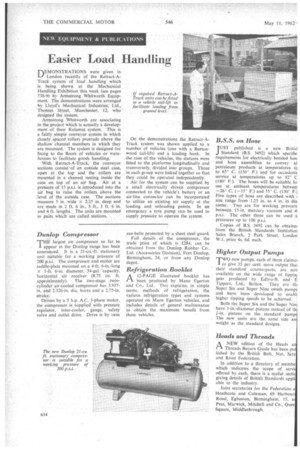Easier Load Handling
Page 60

If you've noticed an error in this article please click here to report it so we can fix it.
DEVIONST RATIONS were given in London recently of the Retract-ATrack system of load handling which is being shown at the Mechanical Handling Exhibition this week (see pages 538-9) by Armstrong Whitworth Equipment. The demonstrations were arranged by Lloyd's Mechanical Industries, Ltd., Thomas Street, Manchester, 12, who designed the system.
Armstrong Whitworth are associating in the project which is actually a develop
merit of their Rolamat system. This is a fairly simple conveyor system in which closely spaced rollers protrude above the shallow channel members in which they are mounted. The system is designed for fixing to the floors of vehicles or warehouses to facilitate goods handling.
With Retract-A-Track, the conveyor sections consist-of an outside steel case, open at the top and the rollers are mounted in a channel resting inside the case on top of an air bag. Air at a pressure of 15 psi. is introduced into the air bag to raise the rollers above the level of the outside case. The sections measure 5 in. wide x 2.25 in, deep and are made in 2 ft. 6 in., 3ft., 3 ft. 6 in. and 4 ft. lengths. The units are mounted in pairs which are called stations. On the demonstrations the Retract-ATrack system was shown applied to a number of vehicles (one with a Burtonwood tail-lift) and a loading bank. In the case of the vehicles, the stations were fitted to the platforms longitudinally and transversely, divided into groups. Those in each group were linked together so that they could be operated independently.
Air for the system can be supplied by a small electrically driven compressor connected to the vehicle's battery or an air-line connector can be incorporated to utilize an existing air supply at the loading and unloading points. In an emergency a tyre pump car . be used to supply pressure to operate the system.
B.S.S. on Hose
ILIST published is a new Britisi Standard (B.S. 3492) which specific requirements for electrically bonded hos1 and hose assemblies to convey al petroleum products at temperatures ui to 65° C. (150° F.) and for occasiona service at temperatures up to 82° C (180° F.). The hoses will be suitable fo use at ambient temperatures betweei —26° Q. (-15° F.) and 55! C. (130° F. Five types of hose are described with size range from 1.25 in. to 4 in. in dia meter. Two are for working pressure between 15-in, mercury vacuum and 41 p.s.i. The other three can be used a pressures up to 100 p.s.i.
Copies of B.S. 3492 can be obtainei from the British Standards Institution Sales Branch, 2 Park Street, London W.1, price 4s. 6d. each.
Higher Output Pumps
TWO new pumps, each of them claimel to give 35 per cent. more °kaput thal their standard counterparts, are nov available on the wide range of tippirn gear produced by Edbro-B. and E Tippers, Ltd., Bolton. They are tit, Super Six and Super Nine swash pumps and have been developed to enabl, higher tipping speeas to be achieved.
Both the Super Six and the Super Nini have I-in.-diameter pistons instead of th f-in. pistons on the standard pump . The new units are the same size an weight as the standard designs.
Heads and Threads
A NEW edition of the Heads a Pin Threads Buyers Guide has been pu lished by the British Bolt, Nut, Sere and Rivet Federation.
In addition to a directory of membe which indicates the scope of servi offered by each, there is a useful sect giving details of British Standards app able to the industry.
Joint secretaries for the Federation a Heathcote and Coleman, 69 Harbour Road, Egbaston, Birmingham, 15, a Peat, Marwick, Mitchell and Co., Quee Square, Middlesbrough.




































































































